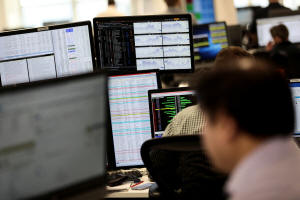Russia-Ukraine turmoil triggers market stress alarms
 Send a link to a friend
Send a link to a friend
 [March 05, 2022] By
Dhara Ranasinghe, Yoruk Bahceli and Gertrude Chavez-Dreyfuss [March 05, 2022] By
Dhara Ranasinghe, Yoruk Bahceli and Gertrude Chavez-Dreyfuss
LONDON/NEW YORK (Reuters) -Financial
indicators signalled increasing signs of stresses spreading through
global markets on Friday as concerns grow over the wider economic
fallout of Russia's invasion of Ukraine.
With stock market prices and bond yields falling, gauges regarded as
stress indicators are attracting investor attention.
The so-called FRA-OIS spread, which measures the gap between the U.S
three-month forward rate agreement and the overnight index swap rate,
hit its highest level since May 2020.
A higher spread reflects rising interbank lending risk or banks hoarding
U.S. dollars, meaning that it is widely viewed as a proxy for banking
sector risk.
The U.S. FRA-OIS spread rose to 32.29 basis points on Friday, compared
with 23.7 on Thursday.
Global alarm was triggered earlier by a blaze at the site of a Ukrainian
nuclear power station, Europe's biggest, after it was seized by Russian
forces. The fire has been extinguished.

"The market's liquidity conditions have weakened this week, and were
exacerbated overnight after reports of shelling to Europe's largest
nuclear plant in Ukraine," said ING currency strategist Francesco Pesole.
Nevertheless, the FRA-OIS gap remains well below levels seen at the
height of market turmoil in 2020.
"Dollar funding conditions are not too alarming at the moment, but the
deterioration in the past week naturally argues in favour of a stronger
dollar," Pesole added.
The dollar index jumped nearly 1%, mainly at the expense of the euro
which has tumbled 3% this week because of Europe's exposure to the
Russian economy.
Another closely-watched short-term funding stress gauge, the spread
between the U.S. three-month Libor and the overnight index swap rate,
rose to more than 18 basis points , its highest since May 2020, as well.
The LIBOR-OIS spread is the credit and term premium a lender would
charge for a three-month unsecured loan over an overnight bank loan,
such as the effective fed funds rate, the risk-free rate set by the
Federal Reserve.
"Our sense is that this week's unsecured funding pressure reflects a
precautionary build up of cash balances that is to some extent
exacerbated by the upcoming Fed hike," wrote Joseph Abate, managing
director, at Barclays in a research note.
[to top of second column] |

U.S. dollar banknotes are displayed in this illustration
taken, February 14, 2022. REUTERS/Dado Ruvic/Illustration

"Although Libor has lost much of its significance since year-end and the end of
banks' ability to put on new trades, the rate is still seen as an early warning
barometer of financial market stress," he added.
DOLLAR SWAPS MARKET, OTHER STRESS METRICS
The demand for dollars was reflected in swap markets where dollar borrowing
costs rose further. For instance, three-month euro-dollar swaps rose to around
27 bps from 15 bps on Thursday.
However, swap rates remained below a March 2020 peak of nearly 40 bps hit on
Monday, and analysts said the Federal Reserve and other major central banks have
mechanisms to relieve funding stress.
Stress metrics are on the rise elsewhere too.
The cost of insuring exposure to a basket of "junk-rated" European company debt
jumped to its highest since July 2020 at 398 bps, the iTraxx European Crossover
index showed.
Another iTraxx index which measures the cost of insuring exposure to senior
bonds from banks and other financial issuers rose 7 bps to 91.7 bps, a May 2020
high.
A European banking stocks index is down 16% this week, reeling from Western
sanctions on Russia, a scaling back of interest rate hike forecasts and a
worsening macroeconomic environment.
Also in focus was the daily number of repo fails, which occur when a market
participant is unable to deliver the security on time to complete a repo
transaction.
Societe Generale said daily repo fails of Treasuries rose to $76.1 billion on
Feb. 28, the highest since June 2020 and more than double the average for this
year.

While repo fails are relatively common, large nubers of failures in volatile
markets suggest dislocations and stress.
(Reporting by Dhara Ranasinghe; Additional reporting by Saikat Chatterjee,
Sujata Rao and Yoruk Bahceli, Gertrude Chavez-Dreyfuss in New York; Editing by
Sujata Rao, Alexander Smith and Marguerita Choy)
[© 2022 Thomson Reuters. All rights
reserved.]This material may not be published,
broadcast, rewritten or redistributed.
Thompson Reuters is solely responsible for this content. |